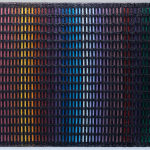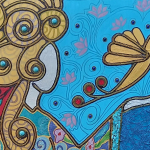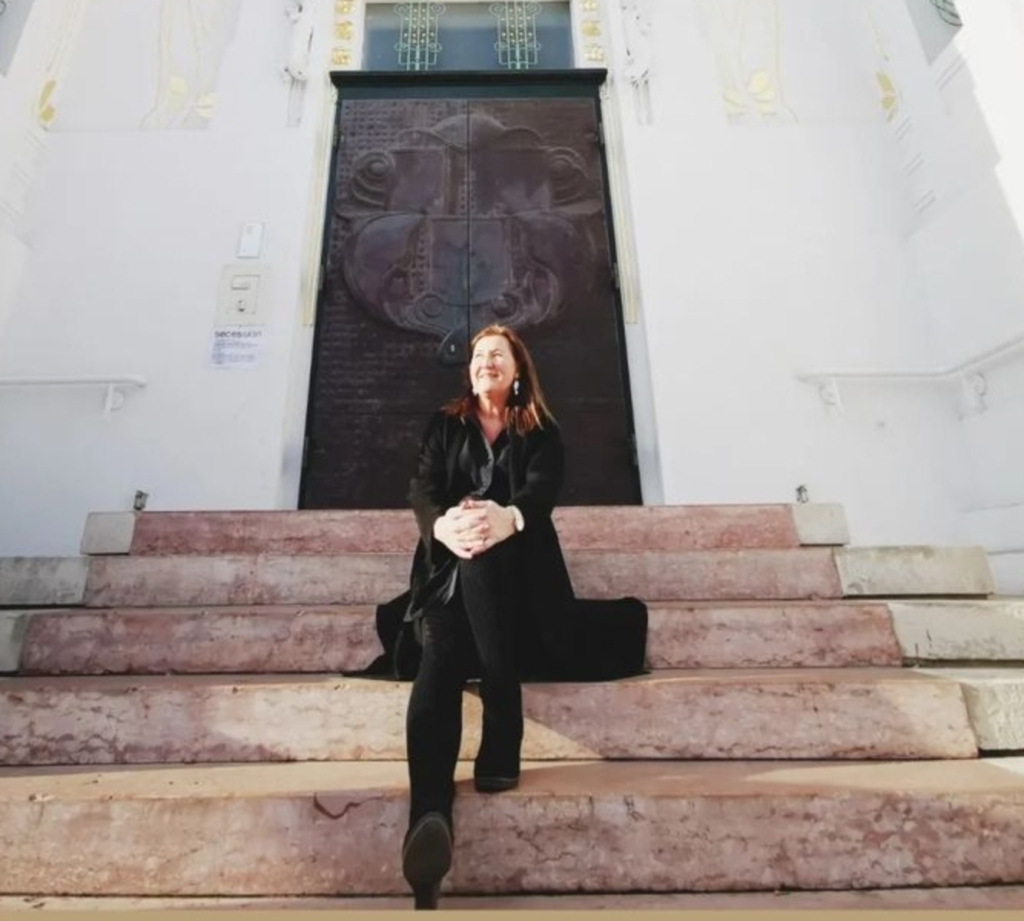
Austriaca di nascita ma trasferitasi per scelta, e anche per amore del paesaggio marino, sulla costa dalmata della Croazia, per la precisione a Korcula, Petra Forman sceglie l’arte come percorso per raccontare tutto ciò che appartiene alla sua interiorità, alla sua natura curiosa e sempre alla ricerca di nuovi stimoli che le permettano di compiere i costanti cambiamenti di cui il suo spirito libero necessita. Pur avendo avuto una formazione commerciale, ha conseguito un master come Executive Management MBA and General Management a Vienna, ha sempre sentito la necessità di lasciare che la sua creatività avesse sfogo affiancando il lato più pragmatico e pratico e per perfezionare il suo istinto naturale, già molto forte, ha sempre seguito corsi di pittura tenuti da vari maestri grazie ai quali ha avuto modo di misurarsi con diversi materiali e stili; attualmente sta frequentando le lezioni di Masterclass del docente d’arte Christian Ludwig Attersee, anche se la forte personalità della Forman mantiene una costante autonomia espressiva che le consente di assorbire le tecniche e le linee guida dei maestri assecondandole poi al suo impulso creativo. Ciò che la affascina del mondo pittorico è la possibilità di creare strati di diversa consistenza che vanno a interagire di fatto con l’ambiente circostante proprio perché vanno a rompere la bidimensionalità e aprono un dialogo più concreto con l’osservatore il quale si lascia incuriosire e affascinare dai graffi, dalle striature e dalla materia che di volta in volta la Forman decide di utilizzare. Le sue opere sono contraddistinte da una pittura granulosa, ruvida così come dalla traccia del tempo che passa, dell’uso ripetuto di un materiale che alla fine si piega a quell’usura, ecco perché spesso nelle sue tele inserisce la ruggine, il legno, la polvere di marmo; anche le tracce del suo amato mare dalmata spesso entrano nei suoi dipinti per interagire in un dialogo armonico tra realtà naturale e sensazioni percepite e suscitate esattamente da quel contatto. I soggetti sono astratti, dunque la sua pittura può rientrare nell’Arte Informale Materica con tendenza al Minimalismo, il quale viene reinterpretato e assoggettato alla necessità della Forman di non utilizzare il colore nella sua stesura bidimensionale, spostandosi invece verso il non colore, le tinte neutre e terrose che appaiono come possibilità interpretativa anche per l’osservatore. Petra Forman lascia fluire le proprie sensazioni in modo incisivo, graffiante, consistente, perché ciò che desidera è che chi si pone davanti a esse sia in qualche modo spinto a lasciarsi travolgere, a entrare in contatto con la propria emotività che lo conduca a dare un’interpretazione personale e intima a ciò che l’artista ha impresso sulla tela.
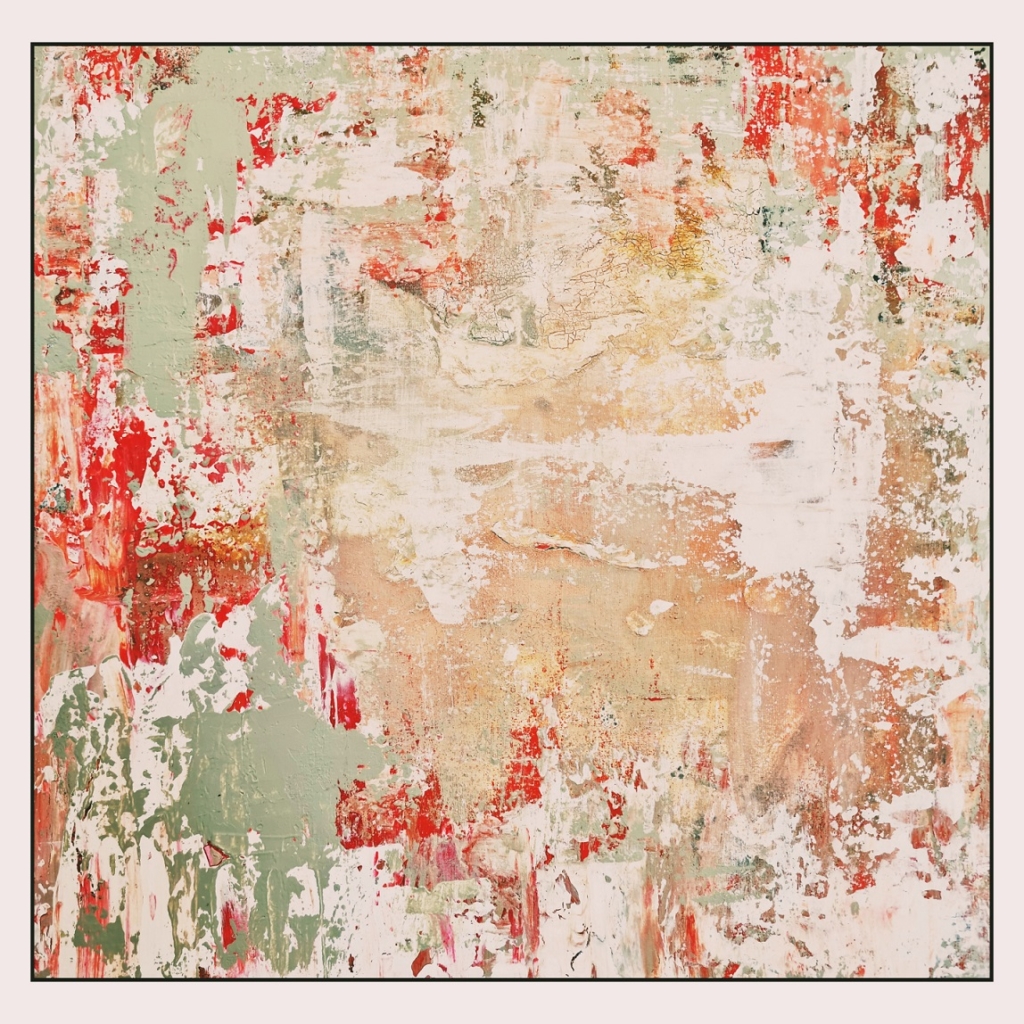
Ama raccontare della natura e di tutto ciò che le ruota intorno, pur dando la sua visione, quella ricerca dell’essenza che appartiene alla sua indole e che la porta a escludere il superfluo, a distaccarsi dalla realtà osservata nella sua spontaneità per andare oltre e respirarne la sostanza, quella capacità di avvolgere l’essere umano e di presentarsi come elemento salvifico, come modo per oltrepassare la superficie e armonizzare l’esterno con l’interno della sensibilità dell’osservatore. La serie Nature è esattamente questo, il lasciar andare la profondità delle emozioni percepite davanti alla bellezza e all’armonia della natura,
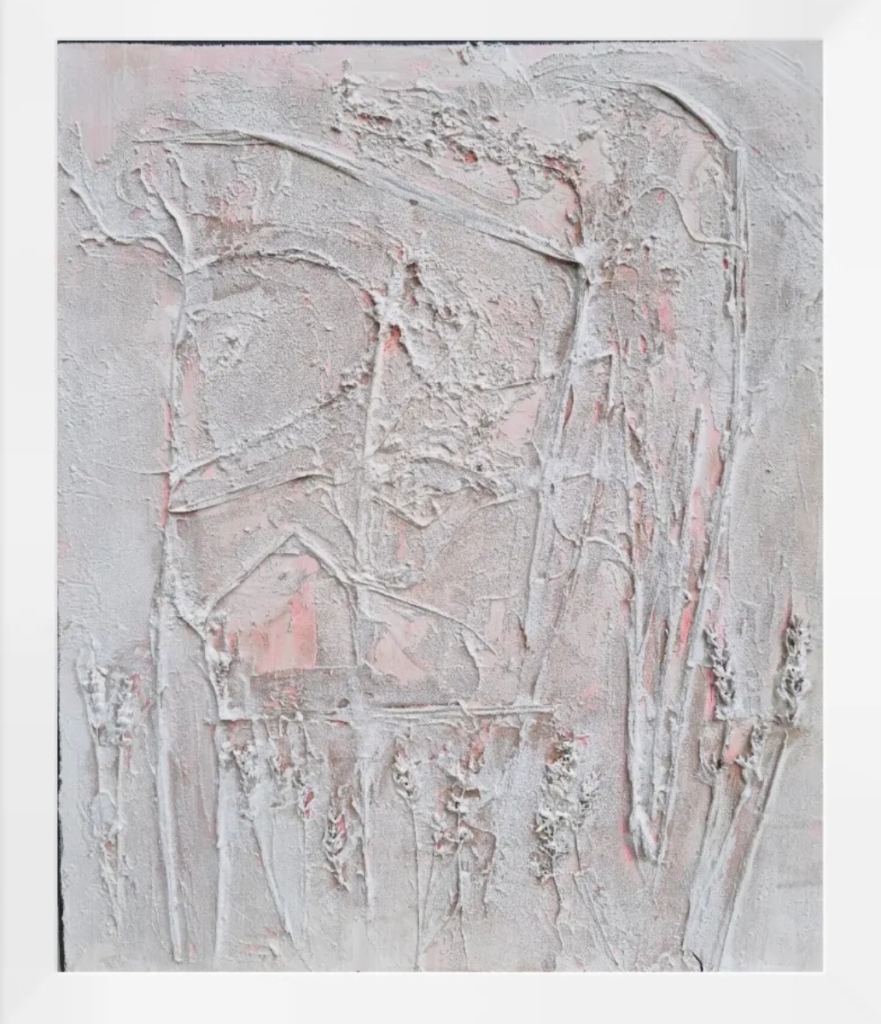
stratificando sulla tela tutta quella gamma di intuizioni che conducono l’artista, e di conseguenza l’osservatore, a porsi in ascolto dell’ambiente circostante, quello che si svela solo nel momento in cui ci si spoglia di tutte le convenzioni e gli aspetti che appartengono alla superficie tendendo così verso il significato nascosto, la voce silenziosa che si può ascoltare solo guardando oltre, chiudendo gli occhi e respirando intensamente tutto ciò che esiste. Dunque il suo è un approccio pittorico di apertura, malgrado l’aspetto minimalista tenda ad apparire ermetico, di interpretazione attraverso il filtro emotivo di quanto appartiene e accompagna la vita. Andiamo ora a scoprire di più di questa particolare e sensibile artista.
Petra, lei ha compiuto la scelta di vita di allontanarsi dal suo paese di origine per trasferirsi in un luogo più suggestivo e forse maggiormente ispirante per il percorso artistico che ha voluto intraprendere. L’evento che l’ha condotta a prendere la decisione era legato alla sua attività imprenditoriale oppure è stato l’istinto creativo a muoverla? Attualmente ha rinunciato alla sua carriera professionale oppure continua a esercitarla parallelamente al cammino artistico?
Ho sempre sognato di vivere al mare e finalmente ho trovato questo posto meraviglioso sul lato sud di Korcula, dove il sole splende quasi tutto l’anno. È stata una scelta voluta il trasferimento in questo nuovo posto per costruire qualcosa di nuovo e lontano dallo stressante mondo tecnologico per passare a una dimensione equilibrata e in perfetta armonia con la natura e lavorare qui su ciò che amo è potenziante. In questo luogo ho ritrovato il mio desiderio interiore di dedicarmi all’arte. In questo ambiente meditativo riesco a mettere su tela le mie impressioni e sentimenti, dunque mi sento nel mio elemento naturale al punto che sto progettando di aprire uno studio più grande. Al momento vivo ancora divisa tra i due mondi e sono di nuovo un po’ più in Austria, ma quando devo lavorare su alcuni progetti artistici corro subito qui perché ora, dopo aver lasciato alle spalle la mia carriera professionale, mi dedico a tempo pieno alla mia arte.
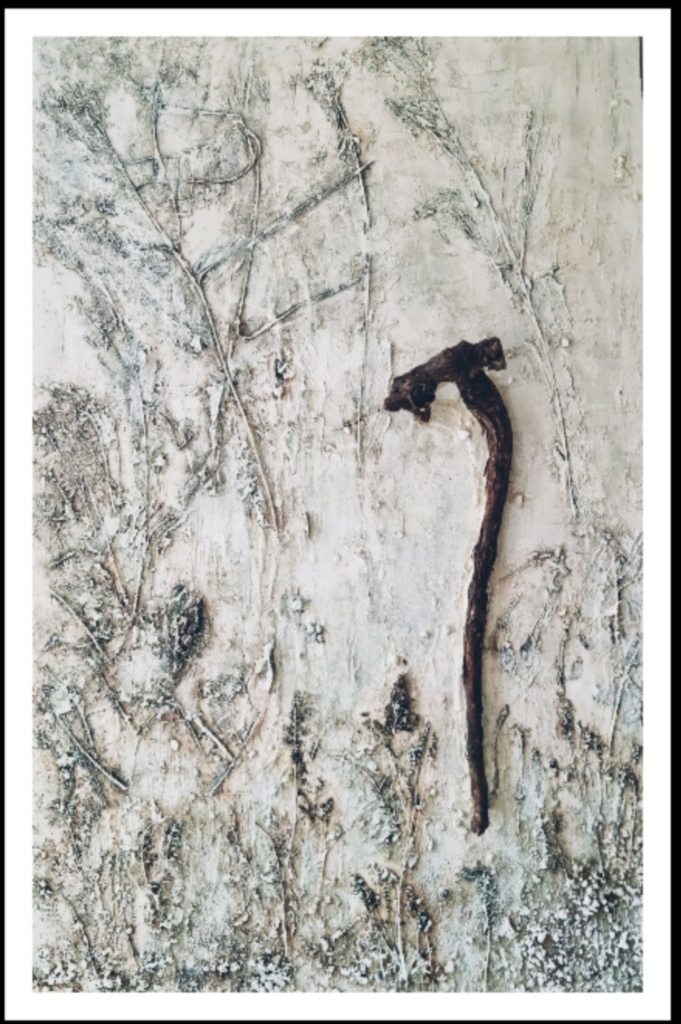
Quanto è importante vivere a picco sul mare per riuscire a entrare in maggiore contatto con la natura? Pensa che esistano dei luoghi particolarmente energetici in grado di permettere a ciascun creativo di liberarsi e lasciarsi andare in maniera più immediata?
Trovo la mia assoluta pace interiore e la mia dimensione in questo posto dunque la vita sembra più facile perché qui conta solo l’essenziale della vita e mi sento lontana anni luce dai ritmi frenetici e stressanti in cui vivevo e vive la società contemporanea. L’orologio ticchetta molto più lentamente qui, c’è così tanta armonia che a volte resto a guardare il mare per intere ore aspettando di trovare l’ispirazione per la mia prossima opera. Non so se per gli altri artisti esista un luogo energetico, probabilmente sì, per me quello dove vivo lo è senz’altro.
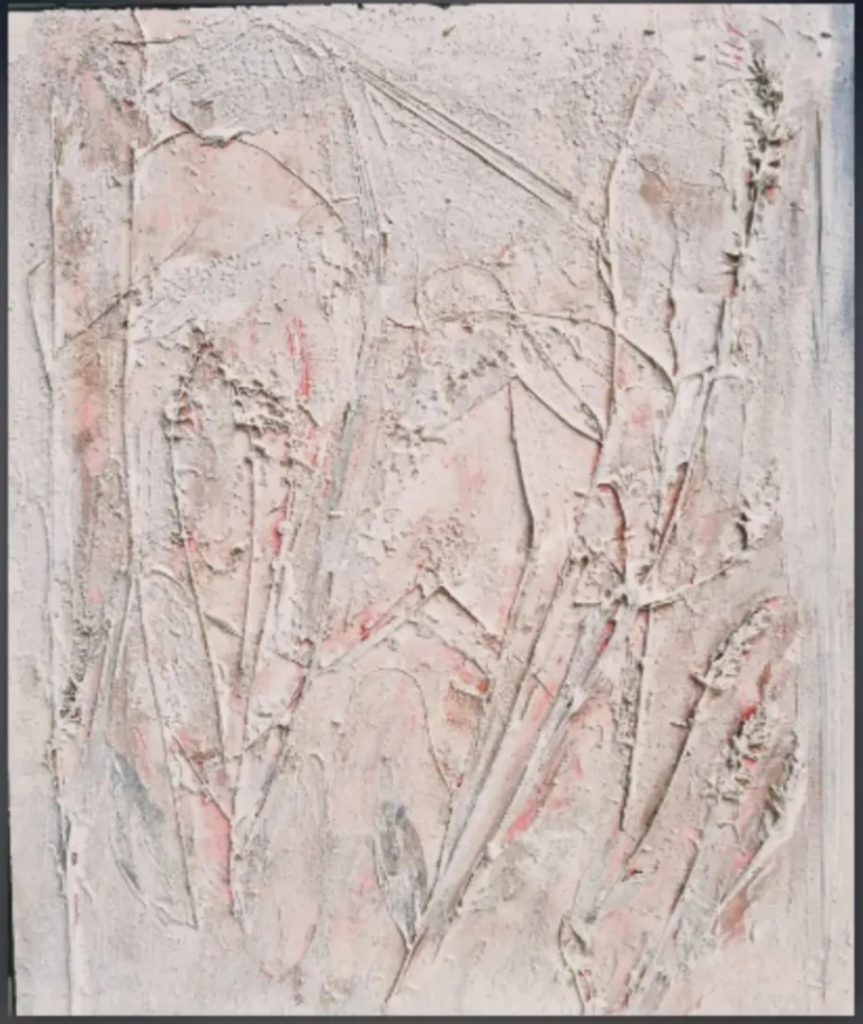
Il suo stile artistico è l’Informale Materico, come mai ha scelto questo genere pittorico? È stata una scelta meditata la sua oppure è stata frutto di una ricerca precedente che poi l’ha guidata verso il linguaggio attuale?
Ho deciso inconsapevolmente di avvicinarmi allo stile dell’Informale Materico forse perché nel mio processo esecutivo mi lascio trasportare dal subconscio e do origine alle opere in maniera del tutto spontanea, sperimentando sempre materiali diversi che poi mescolo con le sfumature di colori affini alla mia emotività del momento. I miei lavori sono spesso molto diversi per rispettare la mia natura sempre alla ricerca della sperimentazione di qualcosa di nuovo così cerco nuovi materiali che posso integrare nelle mie tele.
A parte il suo maestro Attersee, quali sono i grandi artisti del passato che la affascinano di più o che influenzano la sua pittura? È importante secondo lei, a prescindere dal tipo di formazione, conoscere il passato artistico per scrivere una nuova pagina nel presente?
Sono stato alla Biennale de Venezia quest’anno e ho visto la mostra di Anselm Kiefer nel Palazzo Ducale e sono rimasta molto colpita dal suo lavoro, che mi ha ispirato il mio prossimo lavoro dove ho in mente di incorporare nel dipinto un’ampia varietà di materiali. Mi piacerebbe approfondire questo argomento anche nel prossimo anno, studiare in modo più approfondito lo stile di Anselm Kiefer. Conoscere il passato dell’arte è importante perché in fondo noi artisti contemporanei siamo inevitabilmente la somma delle esperienze dei vecchi maestri e dalla loro conoscenza possiamo imparare molto dunque è importante comprendere e abbracciare l’arte precedente per trarne ispirazione e reinterpretarla.
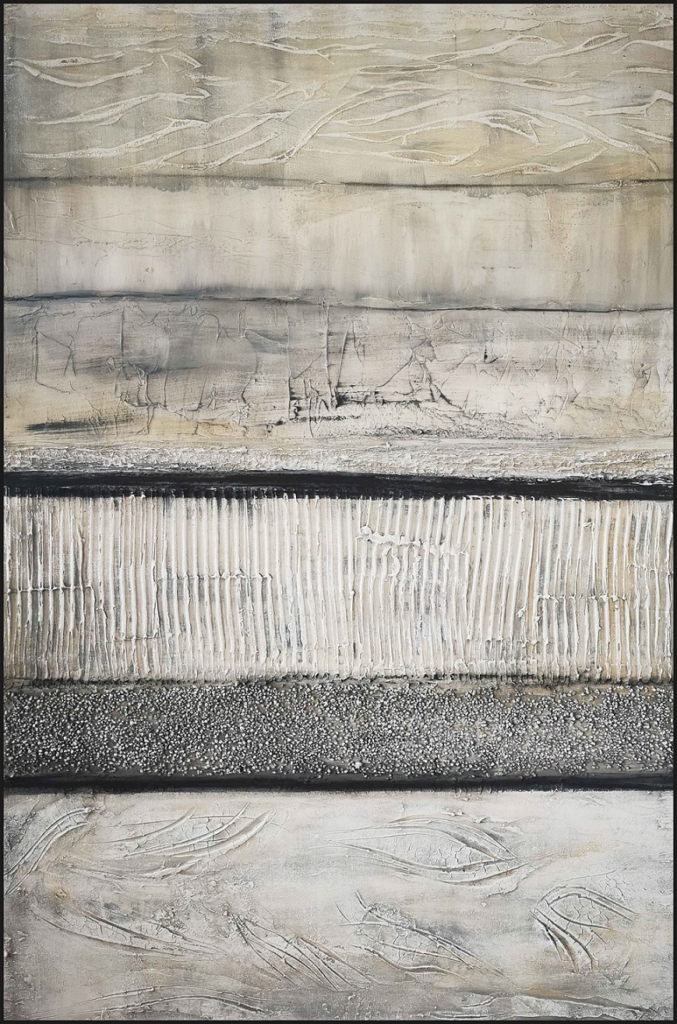
Ha all’attivo mostre a New York, Venezia, Madrid, Parigi, Miami, Vienna e anche mostre virtuali a Londra e Milano. Ècstata invitata alla 59ª Biennale di Venezia 2022 nel Padiglione MUSA e alla 4ª Bienal de Arte Barcelona nel Museo Europeo d’Arte Moderna di Barcellona. Quali sono i suoi prossimi progetti?
Sto per terminare la preparazione della mia prossima mostra dal titolo Minimalismo che avrà luogo presso la Galleria Alberi a Vienna nei primi di dicembre. E ho già alcuni progetti più grandi per il prossimo anno ma anche piccole mostre in programma, tra le altre a Dubrovnik, dove ho pianificato una personale in un Hotel 5 stelle in primavera, e poi una grande mostra personale nella mia città natale in autunno e attualmente mi sto preparando per la Biennale di Firenze e l’Art MUC a Monaco di Baviera. Quindi ci sono già molti progetti nella mia agenda per il prossimo anno che non vedo davvero l’ora di realizzare e vivere.
PETRA FORMAN-CONTATTI
Email: petraforman46@gmail.com
Sito web: https://www.formanpetra.com/
Facebook: https://www.facebook.com/forman.petra
Instagram: https://www.instagram.com/petra_forman/
Marta Lock’s interviews: Petra Forman, the path of art to deepen and manifest emotions and states of mind
Austrian by birth but having moved by choice, and also for love of the seascape, to the Dalmatian coast of Croatia, to Korcula to be precise, Petra Forman chooses art as her path to narrate everything that belongs to her interiority, to her curious nature and always in search of new stimuli that allow her to make the constant changes that her free spirit requires. Although she has had a commercial training, she obtained a Master’s degree as an Executive Management MBA and General Management in Vienna, she has always felt the need to let her creativity have an outlet alongside her more pragmatic and practical side and, in order to perfect her natural instinct, which was already very strong, she has always attended painting courses held by various masters thanks to whom she has had the opportunity to measure herself against different materials and styles; she is currently attending Masterclasses held by art teacher Christian Ludwig Attersee, although Forman’s strong personality maintains a constant expressive autonomy that allows her to absorb the techniques and guidelines of the masters and then follow them to her own creative impulse. What fascinates her about the world of painting is the possibility of creating layers of different consistencies that actually interact with the surrounding environment precisely because they break the two-dimensionality and open up a more concrete dialogue with the observer who is intrigued and fascinated by the scratches, streaks and material that Forman decides to use from time to time. Her works are characterised by a grainy, rough painting as well as by the trace of passing time, of the repeated use of a material that eventually bends to that wear and tear, which is why she often inserts rust, wood, marble dust in her canvases; even traces of her beloved Dalmatian sea often enter her paintings to interact in a harmonious dialogue between natural reality and the sensations perceived and aroused precisely by that contact. The subjects are abstract, so her painting can be included in Informal Textural Art with a tendency towards Minimalism, which is reinterpreted and subjected to Forman’s need not to use colour in its two-dimensional layering, moving instead towards non-colour, neutral and earthy hues that appear as an interpretative possibility for the observer as well. Petra Forman lets her feelings flow in an incisive, biting, consistent manner, because what she wants is for those who stand in front of them to be somehow moved to let themselves be overwhelmed, to get in touch with their own emotionality that leads them to give a personal and intimate interpretation to what the artist has imprinted on the canvas. She loves to tell about nature and everything that revolves around it, while giving her vision, that search for the essence that belongs to her nature and that leads her to exclude the superfluous, to detach herself from reality observed in its spontaneity in order to go beyond it and breathe its substance, that capacity to envelop the human being and to present itself as a saving element, as a way to go beyond the surface and harmonise the outside with the inside of the observer’s sensitivity. The series Nature is exactly this, the letting go of the depth of emotions perceived in front of the beauty and harmony of nature, stratifying on the canvas the whole range of intuitions that lead the artist, and consequently the observer, to listen to the surrounding environment, the one that is revealed only when one strips away all the conventions and aspects that belong to the surface, thus tending towards the hidden meaning, the silent voice that can only be heard by looking beyond, closing one’s eyes and intensely breathing in all that exists. Therefore, hers is a pictorial approach of openness, despite the minimalist aspect tends to appear hermetic, of interpretation through the emotional filter of what belongs to and accompanies life. Let us now discover more about this particular and sensitive artist.
Petra, you made the life choice to move away from your country of origin to a place that was more evocative and perhaps more inspiring for the artistic path you wanted to take. Was the event that led you to make the decision related to your business activity or was it creative instinct that moved you? Have you now given up your professional career or do you continue to pursue it in parallel with your artistic path?
I’ve always dreamed of living by the sea and finally found this wonderful place on the south side of Korcula, where the sun shines almost all year round. It was a deliberate choice to move to this new place to build something new and away from the stressful world of technology to move to a balanced dimension in perfect harmony with nature and working here on what I love is empowering. In this place I found my inner desire to devote myself to art. In this meditative environment I am able to put my impressions and feelings on canvas, so I feel in my natural element to the point that I am planning to open a bigger studio. At the moment I still live torn between the two worlds and I’m back a bit more in Austria, but when I have to work on some art projects I immediately run here because now, having left my professional career behind, I dedicate myself full time to my art.
How important is it to live overlooking the sea to be able to get more in touch with nature? Do you think there are particularly energetic places that allow each creative person to free themselves and let go in a more immediate way?
I find my absolute inner peace and my dimension in this place so life seems easier because here only the essentials of life matter and I feel years away from the frenetic and stressful rhythms in which I lived and where contemporary society lives. The clock ticks much slower here, there is so much harmony that sometimes I stare at the sea for hours waiting to find inspiration for my next work. I don’t know if for other artists there is an energetic place, probably yes, for me the one where I live certainly is.
Your artistic style is Materic Informal, why did you choose this pictorial genre? Was it a meditated choice of yours or was it the result of previous research that then guided you towards your current language?
I unknowingly decided to approach the Informal Material style perhaps because in my executive process I let myself be carried away by the subconscious and I give rise to the works in a completely spontaneous way, always experimenting with different materials which I then mix with shades of colors similar to my emotionality of the moment. My artworks are often very different to respect my nature always looking for experimentation with something new so I look for new materials that I can integrate into my canvases.
Apart from your master Attersee, which great artists of the past fascinate you most or influence your painting? Is it important in your opinion, regardless of one’s training, to know the artistic past in order to write a new page in the present?
I was at the Biennale of Venice this year and saw Anselm Kiefer’s exhibition in Palazzo Ducale and I was very impressed with his work, which inspired my next painting where I plan to incorporate a wide variety of materials into the painting. I would like to delve into this topic again in the next year, study Anselm Kiefer’s style in more depth. Knowing the past of art is important because deep down we contemporary artists are inevitably the sum of the experiences of the old masters and we can learn a lot from their knowledge, therefore it is important to understand and embrace the previous art in order to draw inspiration from it and reinterpret it.
You had exhibitions in New York, Venice, Madrid, Paris, Miami, Vienna and also virtual exhibitions in London and Milan. You were invited to the 59th Venice Biennale 2022 in the MUSA Pavilion and to the 4th Bienal de Arte Barcelona in the European Museum of Modern Art in Barcelona. What are your next projects?
I am about to finish preparing my next exhibition entitled Minimalism which will take place at the Alberi Gallery in Vienna in early December. And I already have some bigger plans for next year but also small exhibitions, among others in Dubrovnik where I will have a solo exhibition in a 5-star hotel in the spring, and then a big solo show in my hometown in the fall and currently preparing for the Florence Biennale and the Art MUC in Munich. So there are already many projects on my agenda for next year which I’m really looking forward to making and living.

